Ode to Infrastructure
A research project by Pan Lu, Bo Wang and Zhou Xin
META Project Space, Shanghai
Building 7, Lane 212, Wu Yuan Street, Xu Hui District, Shanghai
October 29 - January 21, 2016 | Opening: October 29, 6-8pm Is infrastructure something to be praised? Empirically, it represents the mechanical, the rational, and the velocity of the future. But how does this functional system become a kind of aesthetics, and why is it to be lauded as the embodiment of some sublime subject? These are the initial questions of this research project. When the Tibetan khata is offered not towards the iconic leadership, nor the awe-inspiring nature, but rather to the high-speed train across the Qinghai-Tibet plateau, what kind of nature, or culture, is it? Perhaps, we should proclaim that we too are infrastructures, just like how Donna Haraway restored agency back to lichens. Our interest in infrastructure does not align simply with what SL Star characterizes as the “boring things,” nor on the(in)visibility of them. [1] As large-scale technical systems, infrastructures are passages for the means of production such as energy, water, and waste, but also the material forms that mediate digital flow in the contemporary information world. As physical and networked structures, they determine the nature of networks, as well as the speed and direction of movement. Noticeably in the case of China, the current government has initiated a series of large-scale infrastructure projects across the Indian Ocean, such as the Bandung-Jakarta high-speed railway; and else where, with the acquisition of the Gwadar Port in Pakistan, such projects reflect the government’s way to “enter deeply into the world,” [2] and to form regional trade partnerships with non-Western countries across Eurasia. However, we hope to set aside the current obsession with immaterial and speculative projections, as well as the emerging interest in “new materialism” in contemporary anthropology and media studies. We instead look back at some historical images and their contemporary variables, and think about the ways that matter and energy enter into the power structure. The discussion of infrastructure can obviously refer to the dialectical relations between base and superstructure in Marxist philosophy, and certainly tons of official images produced in the early stage of the PRC were heavily influenced by this particular ideology. Images of shadows with large industrial structures in the background, along with those of laboring bodies and their gaze towards the future, have repeatedly appeared in RENMIN HUABAO, a state-published pictorial for mostly foreign reference. It reveals something that is the opposite of what is commonly known as instrumental rationality, that is, how infrastructure produces, rather than reduces the 魅惑, or “the enchantment.” If the word 魅, in Chinese language, refers to a continuation of the haunting past, in English, the word “enchantment” rather signals the religious lyricism of the ode. With a loose reference to the Japanese novelist Juni’ichiro Tanizaki’s classic text IN PRAISE OF SHADOWS, the title of this project also reflects our interest in a new kind of architecture of shadows. [3] To put it simply, this is a preliminary research effort on the politics and poetics of infrastructure. [4] Reference:
1. Susan Leigh Star, “The Ethnography of Infrastructure,” American Behavior Scientist, November 1999 vol. 43 no.3, 377-391.
2. He Zhaotian, “When China Enters Deeply intothe World…” WHEN CHINA ENTERS DEEPLY INTO THE WORLD: THE RISE OF CHINA FROM THE VIEW OF EAST ASIA. Ed. SUZUKI Masahisa. Inter-Asia School, 2016.
3. Ravi Sunduram, “Post post-colonial Sensory Infrastructure,” e-flux Journal 64.
4. Brian Larkin, “The Politics and Poetics of Infrastructure,” Annual Review of Anthropology, Vol. 42: 327-343, 2013. Panel Discussion
October 30, 4-6pm @ META
Speakers: Pan Lu, Bo Wang, Zhou Xin, with Li Juchuan and Jiang Hongsheng
Moderator: Yuan Yajing Researchers / Artists Bio
PAN Lu is Assistant Professor in the Department of Chinese Culture at The Hong Kong Polytechnic University. Pan Lu studied in Shanghai, Bayreuth and Hong Kong. She was visiting scholar and visiting fellow at the Technical University of Berlin(2008 and 2009), the Harvard Yenching Institute (2011-2012), as well as researcher in residence at the Fukuoka Asian Art Museum (2016). Her art work appeared in Urban Living Room, the 10th Shanghai Biennale and her film project“TRACES OF AN INVISIBLE CITY” entered Asian Competition section at DMZ International Documentary Film Festival, South Korea in 2016. She has also been selected as artist in residence at Center for Art and Urbanistics, Berlin, Germany (Oct- Dec, 2016). Pan is author of two monographs in English: IN VISIBLE PALIMPSEST: MEMORY, SPACE AND MODERNITY IN BERLIN AND SHANGHAI (Bern: Peter Lang, 2016) and AESTHETICIZING PUBLIC SPACE: STREET VISUAL POLITICS IN EAST ASIAN CITIES (Bristol and Chicago: Intellect/University of Chicago Press, 2015). Bo WANG is an artist and filmmaker based in Brooklyn, New York. His works have been exhibited internationally, including venues like MoMA in New York, CPH: DOX in Copenhagen, Shanghai Biennale, Times Art Museum in Guangzhou, Asia Society Texas Center, DMZ Docs in South Korea, DOKU. ARTS at German Historical Museum in Berlin, among many others. He was artist in residency at NTU CCA Singapore in 2016, fellow at the Robert Flaherty Film Seminar in 2013 and attended the Berlinale Talents programme at Berlin International Film Festival in 2014. He is also a faculty member at the Visual and Critical Studies program at the School of Visual Arts, New York. ZHOU Xin is a researcher, writer and curator based in Hong Kong and New York. He has curated public programs and film series at Anthology Film Archives (NYC), Carpenter Center for the Visual Arts (Boston), Institute of Contemporary Art/Boston,UnionDocs Center for Documentary Art (Brooklyn), OCT Loft (Shenzhen), The Performing Garage (NYC), and else where. Recent project is MONSOON, PRAYERS, NEW ROUTES: URBAN ISIAM ACROSS THE INDIAN OCEAN at the Institute of Contemporary Art/Boston. His writing has appeared in Artforum (China), The Brooklyn Rail, Film Comment, Social Factory: 10th Shanghai Biennale exhibition catalogue, and elsewhere. He has a MA in Cinema Studies from New York University, and is currently a Research Associate in the Department of Chinese Culture at the Hong Kong Polytechnic University. Respondents Bio
JIANG Hongsheng (b. 1972, Chaling, PRC) is an Associate Professor in the Chinese Department at Peking University. He has a PhD in Literature from Duke University. Jiang’s research interests include cultural history, critical theory, comparative literature, and the inter-East-Asian historical, cultural and political studies. He has published many journal articles, including “Jacques Ranciere's Regimes of Art and Contemporary Political Art,” “Michel Foucault’s Archeology of Knowledge and Its Discontents,” “Fredric Jameson’s Studies of Utopia and His Anti-anti-Utopianism,” etc. In 2014, he published a book titled LA COMMUNE DE SHANGHAI ET LA COMMUNE DE PARIS (préface d’Alain Badiou, Paris: La Fabrique). LI Juchuan (b. 1964, Shashi, Hubei) is an artist and architect based in Wuhan, China. He studied urban planning at the Wuhan Urban and Architecture Institute, and has taught at the Department of Architecture at the Wuhan Polytechnic University and the Institute of Architecture at Nanjing University. Since 1990, Li began his architectural and artistic practice, working in the intersection between performance, video, photography, and site-specific installation. About META Project Space
Founded in 2014, META Project Space will only host not-for-profit projects starting from 2016. META Project Space will continue its site-specific experimental series. Focusing its attention primarily on installation and moving image, META also sponsors research-based projects and small symposiums on related topics.
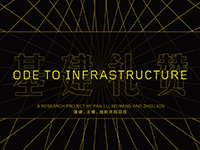 |
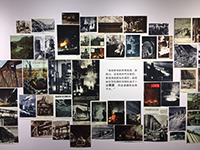 |
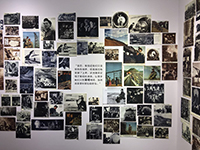 |
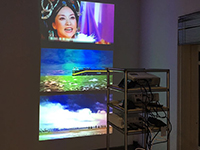 |
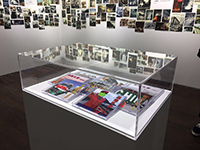 |
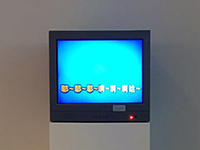 |
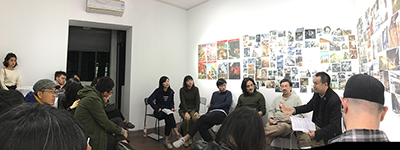 |
Building 7, Lane 212, Wu Yuan Street, Xu Hui District, Shanghai
October 29 - January 21, 2016 | Opening: October 29, 6-8pm Is infrastructure something to be praised? Empirically, it represents the mechanical, the rational, and the velocity of the future. But how does this functional system become a kind of aesthetics, and why is it to be lauded as the embodiment of some sublime subject? These are the initial questions of this research project. When the Tibetan khata is offered not towards the iconic leadership, nor the awe-inspiring nature, but rather to the high-speed train across the Qinghai-Tibet plateau, what kind of nature, or culture, is it? Perhaps, we should proclaim that we too are infrastructures, just like how Donna Haraway restored agency back to lichens. Our interest in infrastructure does not align simply with what SL Star characterizes as the “boring things,” nor on the(in)visibility of them. [1] As large-scale technical systems, infrastructures are passages for the means of production such as energy, water, and waste, but also the material forms that mediate digital flow in the contemporary information world. As physical and networked structures, they determine the nature of networks, as well as the speed and direction of movement. Noticeably in the case of China, the current government has initiated a series of large-scale infrastructure projects across the Indian Ocean, such as the Bandung-Jakarta high-speed railway; and else where, with the acquisition of the Gwadar Port in Pakistan, such projects reflect the government’s way to “enter deeply into the world,” [2] and to form regional trade partnerships with non-Western countries across Eurasia. However, we hope to set aside the current obsession with immaterial and speculative projections, as well as the emerging interest in “new materialism” in contemporary anthropology and media studies. We instead look back at some historical images and their contemporary variables, and think about the ways that matter and energy enter into the power structure. The discussion of infrastructure can obviously refer to the dialectical relations between base and superstructure in Marxist philosophy, and certainly tons of official images produced in the early stage of the PRC were heavily influenced by this particular ideology. Images of shadows with large industrial structures in the background, along with those of laboring bodies and their gaze towards the future, have repeatedly appeared in RENMIN HUABAO, a state-published pictorial for mostly foreign reference. It reveals something that is the opposite of what is commonly known as instrumental rationality, that is, how infrastructure produces, rather than reduces the 魅惑, or “the enchantment.” If the word 魅, in Chinese language, refers to a continuation of the haunting past, in English, the word “enchantment” rather signals the religious lyricism of the ode. With a loose reference to the Japanese novelist Juni’ichiro Tanizaki’s classic text IN PRAISE OF SHADOWS, the title of this project also reflects our interest in a new kind of architecture of shadows. [3] To put it simply, this is a preliminary research effort on the politics and poetics of infrastructure. [4] Reference:
1. Susan Leigh Star, “The Ethnography of Infrastructure,” American Behavior Scientist, November 1999 vol. 43 no.3, 377-391.
2. He Zhaotian, “When China Enters Deeply intothe World…” WHEN CHINA ENTERS DEEPLY INTO THE WORLD: THE RISE OF CHINA FROM THE VIEW OF EAST ASIA. Ed. SUZUKI Masahisa. Inter-Asia School, 2016.
3. Ravi Sunduram, “Post post-colonial Sensory Infrastructure,” e-flux Journal 64.
4. Brian Larkin, “The Politics and Poetics of Infrastructure,” Annual Review of Anthropology, Vol. 42: 327-343, 2013. Panel Discussion
October 30, 4-6pm @ META
Speakers: Pan Lu, Bo Wang, Zhou Xin, with Li Juchuan and Jiang Hongsheng
Moderator: Yuan Yajing Researchers / Artists Bio
PAN Lu is Assistant Professor in the Department of Chinese Culture at The Hong Kong Polytechnic University. Pan Lu studied in Shanghai, Bayreuth and Hong Kong. She was visiting scholar and visiting fellow at the Technical University of Berlin(2008 and 2009), the Harvard Yenching Institute (2011-2012), as well as researcher in residence at the Fukuoka Asian Art Museum (2016). Her art work appeared in Urban Living Room, the 10th Shanghai Biennale and her film project“TRACES OF AN INVISIBLE CITY” entered Asian Competition section at DMZ International Documentary Film Festival, South Korea in 2016. She has also been selected as artist in residence at Center for Art and Urbanistics, Berlin, Germany (Oct- Dec, 2016). Pan is author of two monographs in English: IN VISIBLE PALIMPSEST: MEMORY, SPACE AND MODERNITY IN BERLIN AND SHANGHAI (Bern: Peter Lang, 2016) and AESTHETICIZING PUBLIC SPACE: STREET VISUAL POLITICS IN EAST ASIAN CITIES (Bristol and Chicago: Intellect/University of Chicago Press, 2015). Bo WANG is an artist and filmmaker based in Brooklyn, New York. His works have been exhibited internationally, including venues like MoMA in New York, CPH: DOX in Copenhagen, Shanghai Biennale, Times Art Museum in Guangzhou, Asia Society Texas Center, DMZ Docs in South Korea, DOKU. ARTS at German Historical Museum in Berlin, among many others. He was artist in residency at NTU CCA Singapore in 2016, fellow at the Robert Flaherty Film Seminar in 2013 and attended the Berlinale Talents programme at Berlin International Film Festival in 2014. He is also a faculty member at the Visual and Critical Studies program at the School of Visual Arts, New York. ZHOU Xin is a researcher, writer and curator based in Hong Kong and New York. He has curated public programs and film series at Anthology Film Archives (NYC), Carpenter Center for the Visual Arts (Boston), Institute of Contemporary Art/Boston,UnionDocs Center for Documentary Art (Brooklyn), OCT Loft (Shenzhen), The Performing Garage (NYC), and else where. Recent project is MONSOON, PRAYERS, NEW ROUTES: URBAN ISIAM ACROSS THE INDIAN OCEAN at the Institute of Contemporary Art/Boston. His writing has appeared in Artforum (China), The Brooklyn Rail, Film Comment, Social Factory: 10th Shanghai Biennale exhibition catalogue, and elsewhere. He has a MA in Cinema Studies from New York University, and is currently a Research Associate in the Department of Chinese Culture at the Hong Kong Polytechnic University. Respondents Bio
JIANG Hongsheng (b. 1972, Chaling, PRC) is an Associate Professor in the Chinese Department at Peking University. He has a PhD in Literature from Duke University. Jiang’s research interests include cultural history, critical theory, comparative literature, and the inter-East-Asian historical, cultural and political studies. He has published many journal articles, including “Jacques Ranciere's Regimes of Art and Contemporary Political Art,” “Michel Foucault’s Archeology of Knowledge and Its Discontents,” “Fredric Jameson’s Studies of Utopia and His Anti-anti-Utopianism,” etc. In 2014, he published a book titled LA COMMUNE DE SHANGHAI ET LA COMMUNE DE PARIS (préface d’Alain Badiou, Paris: La Fabrique). LI Juchuan (b. 1964, Shashi, Hubei) is an artist and architect based in Wuhan, China. He studied urban planning at the Wuhan Urban and Architecture Institute, and has taught at the Department of Architecture at the Wuhan Polytechnic University and the Institute of Architecture at Nanjing University. Since 1990, Li began his architectural and artistic practice, working in the intersection between performance, video, photography, and site-specific installation. About META Project Space
Founded in 2014, META Project Space will only host not-for-profit projects starting from 2016. META Project Space will continue its site-specific experimental series. Focusing its attention primarily on installation and moving image, META also sponsors research-based projects and small symposiums on related topics.